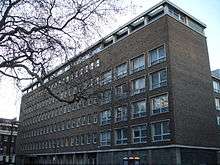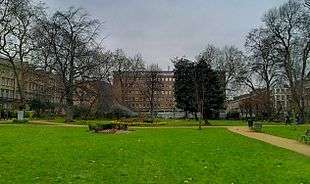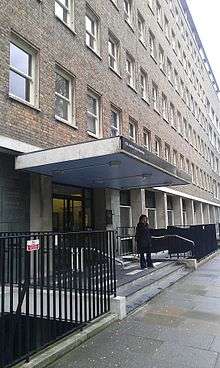UCL Institute of Archaeology
 | |
| Established | 1937 |
|---|---|
| Founder | Mortimer Wheeler |
| Director | Sue Hamilton |
Academic staff | 70[1] |
| Students | 650[1] |
| Undergraduates | 300 |
| Postgraduates | 350 |
| Location | 31-34 Gordon Square, London, UK |
| Campus | Urban |
| Website | www.ucl.ac.uk/archaeology |
The UCL Institute of Archaeology is an academic department of the Social & Historical Sciences Faculty of University College London (UCL), England which it joined in 1986. It is currently one of the largest centres for the study of archaeology, cultural heritage and museum studies in the world, with over 100 members of staff and 600 students housed in a 1950s building on the north side of Gordon Square in the Bloomsbury area of Central London.
History
The history of the Institute of Archaeology goes back to Mortimer Wheeler's vision of creating a centre for archaeological training in Britain, which he conceived in the 1920s. Thanks to the efforts of Wheeler and his wife Tessa, his ambitions were realised when the Institute was officially opened in 1937, with Mortimer Wheeler as its first director. Among its early members of staff were some of the founding ancestors of archaeology in Britain. Foremost among these, apart from Wheeler himself, was V. Gordon Childe, director from 1946 to 1957, but there were many others, including Kathleen Kenyon, excavator of Jericho, initially secretary then the Institute’s acting director during World War II; F. E. Zeuner, one of the founders of quaternary studies and of zooarchaeology; Joan du Plat Taylor, the Institute’s librarian for many years, who was a pioneer of underwater archaeology; and Max Mallowan, Professor of Western Asiatic Archaeology (and second husband of Agatha Christie). Mortimer Wheeler formally resigned as Honorary Director in 1944 when he became Director-General of the Archaeological Survey of India and, at the end of the Second World War, the Directorship was awarded to V. Gordon Childe. Following Childe’s retirement, this role passed to W. F. Grimes, like Wheeler a former Director of the London Museum, and best known today for his 1954 excavation of the London Mithraeum. Following Grimes, the Directorship has been held by the Mediterranean prehistorian John Davies Evans; the geographer David R. Harris; Peter Ucko, founder of the World Archaeological Congress and the prehistorian and evolutionary theorist Stephen Shennan. It is currently held by prehistorian Sue Hamilton. Initially the Institute was based in St John’s Lodge, Regent's Park, London, but in 1958 it moved into its purpose-built new premises in Gordon Square. 2012 marked the Institute's 75th anniversary and a number of events and activities were held to mark this occasion. [2][3][4][5]
Research and teaching

Research at the Institute covers fieldwork, laboratory analysis and conservation, artefact studies, and theoretical, synthetic, and analytical work. Staff projects are currently undertaken on five continents and in the Pacific. A research directory outlining research projects, centres and networks at the Institute of Archaeology is available on the Institute website.[6] Current research projects include:
- The Stones of Stonehenge[7]
- Rapa Nui Landscapes of Construction[8]
- Cultural Evolution of Neolithic Europe[9]
- Imperial Logistics: The Making of the Terracotta Army[10]
In the 2014 Research Excellence Framework (REF), the Institute of Archaeology received the top score of 100% 4* for the excellence of its research environment. Two thirds (66%) of its research outputs were rated in the 4* or 3* categories (world leading and internationally excellent) while nearly 50% of its research impact was deemed to be of 4* quality.[11]
The Institute offers a diverse range of Undergraduate Degrees, Master's degrees and Research Degrees.[12] The Institute of Archaeology was rated number one for Archaeology and Forensics in the Guardian University Guide for 2015 for the fourth year in a row.[13] It has also been ranked in the top two for student satisfaction in the Complete University Guide's 2015 League Table of UK archaeology departments.[14]
In the QS World University Rankings by Subject 2016 UCL is ranked 3rd in the world (and 3rd in Europe) for Archaeology.[15]
Facilities, collections and library
The Institute’s facilities include the Wolfson Archaeological Science Laboratories and other laboratories for conservation teaching and research, GIS, photography, lithic analysis and for environmental teaching and research activities.[16]
The Institute of Archaeology Collections contain c. 80,000 objects that are used in teaching, research and outreach. Archaeological materials include ceramics, lithics and other objects from a range of periods across Europe, Africa, Egypt, the Levant, Mesopotamia, Pakistan, India, Mesoamerica, South America and the Caribbean. Notable collectors include Flinders Petrie (the Petrie Palestinian Collection), Kathleen Kenyon, Beatrice de Cardi, W.L. Hildburgh, R.G. Gayer-Anderson and Mortimer Wheeler. There are also extensive collections of archaeobotanical and zooarchaeological material which act as primary sources for the identification of plant and animal remains. Further collections of minerals, slag and other materials provide teaching resources for the study of ancient technology.[17]
The A.G. Leventis Gallery of Cypriot and Eastern Mediterranean Archaeology is a public display of part of the collections of the Institute of Archaeology, with objects from ancient Cyprus, Greece, Crete, Egypt and the Levant. The gallery is open Monday to Friday, 9am-5pm; entry is free.[18]
The Institute Library was founded in 1937 to support teaching and learning at the new Institute of Archaeology and has subsequently gained an international reputation as one of the most extensive collections of printed material in the world relating to all aspects of archaeology, museum studies and cultural heritage.[19] The library also contains the Yates Classical Archaeology library and the Edwards Egyptology library. The Institute Library is now part of UCL Library Services.[20] Related collections of interest are to be found in the Main Library (Ancient History, Jewish Studies, Latin American History, History and Classics) and in the DMS Watson (Science Library) (Anthropology, History of Science and Geography).[21]
Publications

The Institute publishes research monographs and edited volumes in association with Left Coast Press who also now produce and distribute older Institute of Archaeology publications.[22]
The Institute produces the following 'in-house' publications (in conjunction with Ubiquity Press):
- Archaeology International'[23]
- Journal of Conservation and Museum Studies[24]
- Papers from the Institute of Archaeology (PIA)[25]
- Present Pasts[26]
Institute of Archaeology undergraduate students produce Artifact magazine (available online).[27]
Public Archaeology is a journal sponsored by the Institute, launched in 2000 as an international peer-reviewed journal with a focus on the issues of cultural heritage, community archaeology and archaeological practice as it relates to wider civil and governmental concerns. The journal was originally edited by Neal Ascherson; it is now edited by Tim Schadla-Hall. Issued quarterly, it was originally published by James & James Science Publishers until 2007, when the publishing rights were purchased by Maney Publishing.[28]
Research divisions
The Centre for Applied Archaeology (CAA) is a research and support division within the UCL Institute of Archaeology which offers professional advice, support and training in cultural resource management, archaeology, conservation, interpretation and project management.[29] Archaeology South-East (ASE) is the contracts division of the Centre for Applied Archaeology. It offers services in all areas of archaeological practice.[30]
The International Centre for Chinese Heritage and Archaeology, based at the Institute, is a joint association between the School for Archaeology and Museology of Peking University and the UCL Institute of Archaeology.[31]
News, events and social media
The Institute of Archaeology regularly publishes news and events, including details of seminars, conferences, job opportunities, recent press coverage, publications and other announcements.[32] The Institute also has a presence on Facebook,[33] Twitter[34] and YouTube.[35] An annual open day, a 'Festival of World Archaeology', is normally held in June, providing fun, archaeology-related activities for children and adults alike.[36]
List of directors
- Mortimer Wheeler (1937 to 1946)
- Kathleen Kenyon (1939 to 1946); acting director during World War II
- Professor V. Gordon Childe (1946 to 1957)
- Professor W. F. Grimes (1957 to 1975)
- John Davies Evans (1975 to 1989)
- Professor David R. Harris (1989 to 1996)
- Professor Peter Ucko (1996 to 2005)
- Professor Stephen Shennan (2005 to 2014)
- Professor Sue Hamilton (2014 to present)
Images
 Leventis Gallery
Leventis Gallery Library
Library
References
- 1 2 Introduction to the Institute, Institute of Archaeology, University College London, UK.
- ↑ British Archaeology Issue 124, May/June 2012 http://www.britisharchaeology.org/ba124
- ↑ 75th anniversary article by Dr Gabriel Moshenska reproduced on the IoA website from British Archaeology Issue 124, May/June 2012 http://www.ucl.ac.uk/archaeology/about/75th_anniversary/75th_article
- ↑ Evans, J.D. (1987) The First Half-Century - and After. Institute of Archaeology Golden Jubilee Bulletin. No 24
- ↑ "The 75th Anniversary Programme". Retrieved 19 June 2015.
- ↑ "Research Directory". Retrieved 19 June 2015.
- ↑ "The Stones of Stonehenge". Retrieved 19 June 2015.
- ↑ "Rapa Nui Landscapes of Construction". Retrieved 19 June 2015.
- ↑ "Cultural Evolution of Neolithic Europe". Retrieved 19 June 2015.
- ↑ "Imperial Logistics: The Making of the Terracotta Army". Retrieved 19 June 2015.
- ↑ "Results & submissions : REF 2014 : View results and submissions by UOA". Retrieved 19 June 2015.
- ↑ "Study Here". Retrieved 19 June 2015.
- ↑ "University guide 2015: league table for forensic science and archaeology". the Guardian. Retrieved 19 June 2015.
- ↑ "Archaeology - Top UK University Subject Tables and Rankings 2016". Retrieved 19 June 2015.
- ↑ "QS World University Rankings by Subject 2016 - Archaeology". QS Quacquarelli Symonds Limited. Retrieved 11 October 2016.
- ↑ "Facilities". Retrieved 19 June 2015.
- ↑ "The Institute of Archaeology Collections". Retrieved 19 June 2015.
- ↑ "Visit". Retrieved 19 June 2015.
- ↑ "History of the Institute of Archaeology Library and Collections". Retrieved 19 June 2015.
- ↑ "UCL Institute of Archaeology Library". Retrieved 19 June 2015.
- ↑ "UCL Library Services". Retrieved 19 June 2015.
- ↑ "Left Coast Press : Our Books By Series". Retrieved 19 June 2015.
- ↑ "Archaeology International". Retrieved 19 June 2015.
- ↑ "Journal of Conservation and Museum Studies". Retrieved 19 June 2015.
- ↑ "Papers from the Institute of Archaeology". Retrieved 19 June 2015.
- ↑ "Present Pasts". Retrieved 19 June 2015.
- ↑ "ISSUU - Artifact magazine". Retrieved 19 June 2015.
- ↑ "Maney acquires Earthscan heritage list" (Press release). Maney Publishing. 5 February 2007. Retrieved 2008-08-22.
- ↑ "Centre for Applied Archaeology". Retrieved 19 June 2015.
- ↑ "Archaeology South-East". Retrieved 19 June 2015.
- ↑ "iccha". Retrieved 19 June 2015.
- ↑ "News and Events". Retrieved 19 June 2015.
- ↑ "UCL Archaeology". Facebook. Retrieved 19 June 2015.
- ↑ "UCL Archaeology". Retrieved 19 June 2015.
- ↑ UCL Institute of Archaeology. YouTube. 21 February 2013. Retrieved 19 June 2015.
- ↑ "2015 World Archaeology Festival - UCL Institute of Archaeology". 2015 World Archaeology Festival - UCL Institute of Archaeology. Retrieved 19 June 2015.
External links
- UCL Institute of Archaeology
- Centre for Applied Archaeology (CAA)
- Archaeology South-East
- International Centre for Chinese Heritage and Archaeology
Coordinates: 51°31′30″N 0°7′54″W / 51.52500°N 0.13167°W